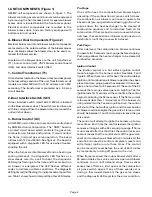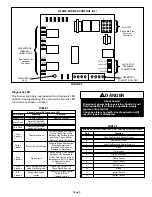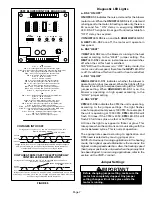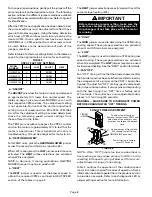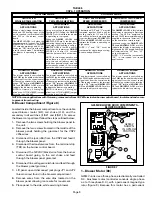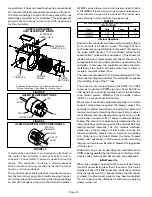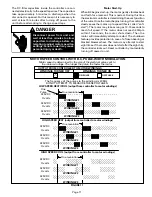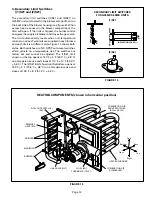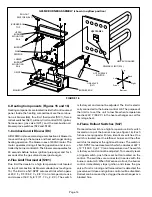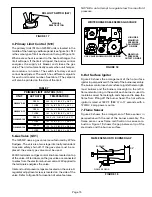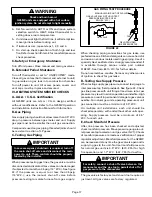
Page 17
WARNING
Shock and burn hazard.
G25MV units are equipped with a hot surface
ignition system. Do not attempt to light manually.
4– Set fan switch to AUTO or ON and move system
selection switch to HEAT. Adjust thermostat to a
setting above room temperature.
5– If unit does not light the first time, it will attempt two
more ignitions before locking out.
6– If lockout occurs, repeat steps 1, 2, 3 and 4.
7– On start-up check operation of both high and low
fire. Refer to section IV item E for manifold pressure
check procedure.
C–Safety or Emergency Shutdown
Turn off unit power. Close manual and main gas valves.
D–Extended Period Shutdown
Turn off thermostat or set to “UNOCCUPIED” mode.
Close all gas valves (both internal and external to unit)
to guarantee no gas leak into combustion chamber.
Turn off power to unit. All access panels, covers and
vent caps must be in place and secured.
IV–HEATING SYSTEM SERVICE CHECKS
A–A.G.A. / C.G.A. Certification
All G25MV units are A.G.A. / C.G.A. design certified
without modifications. Refer to the G25MV Operation
and Installation Instruction Manual for Information.
B–Gas Piping
Gas supply piping should not allow more than 0.5”W.C.
drop in pressure between gas meter and unit. Supply
gas pipe must not be smaller than unit gas connection.
Compounds used on gas piping threaded joints should
be resistant to action of LP gases.
C–Testing Gas Piping
IMPORTANT
In case emergency shutdown is required, turn off
the main shut-off valve and disconnect the main
power to unit. These controls should be properly
labeled by the installer.
When pressure testing gas lines, the gas valve must be
disconnected and isolated. Gas valves can be damaged
if subjected to more than 0.5psig (14” W.C.). See figure
22
. If the pressure is equal to or less than 0.5psig
(14”W.C.), use the manual shut–off valve before
pressure testing to isolate furnace from gas supply.
FIGURE 22
MANUAL MAIN SHUT–OFF VALVE
GAS VALVE WILL NOT HOLD TEST
PRESSURE IN EXCESS OF 0.5
PSIG (14”W.C.)
GAS VALVE
CAP
GAS PIPING TEST PROCEDURE
FIELD PROVIDED
LINE PRESSURE TAP
When checking piping connections for gas leaks, use
preferred means. Kitchen detergents can cause harmful
corrosion on various metals used in gas piping. Use of a
specialty Gas Leak Detector is strongly recommended. It
is available through Lennox under part number
31B2001. See Corp. 8411–L10, for further details.
Do not use matches, candles, flame or any other source
of ignition to check for gas leaks.
D–Testing Gas Supply Pressure
When testing supply gas pressure, connect test gauge to
inlet pressure tap (field provided). See figure 22. Check
gas line pressure with unit firing at maximum rate. Low
pressure may result in erratic operation or underfire. High
pressure can result in permanent damage to gas valve or
overfire. For natural gas units, operating pressure at unit
gas connection must be a minimum of 4.5” W.C.
On multiple unit installations, each unit should be
checked separately, with and without other units oper-
ating. Supply pressure must be a minimum of 4.5”
W.C. for each unit.
E–Check Manifold Pressure
After line pressure has been checked and adjusted,
check manifold pressure. Move pressure gauge to out-
let pressure tap located on unit gas valve (GV1). Checks
of manifold pressure are made as verification of proper
regulator adjustment. Manifold pressure for the G25MV
can be measured at any time the gas valve is open and is
supplying gas to the unit. Normal manifold pressure
for natural gas units is 3.5” W.C. (870.2 Pa) for high
fire operation and 1.7” W.C. (422.7 Pa) for low fire.
IMPORTANT
For safety, connect a shut-off valve between the
manometer and the gas tap to permit shut off of
gas pressure to the manometer.
The gas valve is factory set and should not require ad-
justment. All gas valves are factory regulated.


